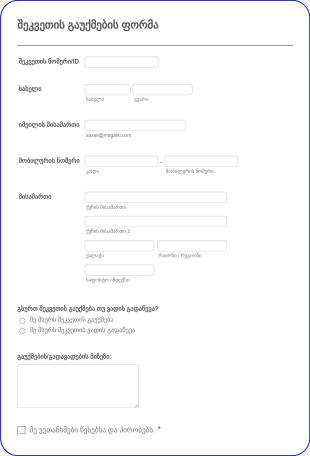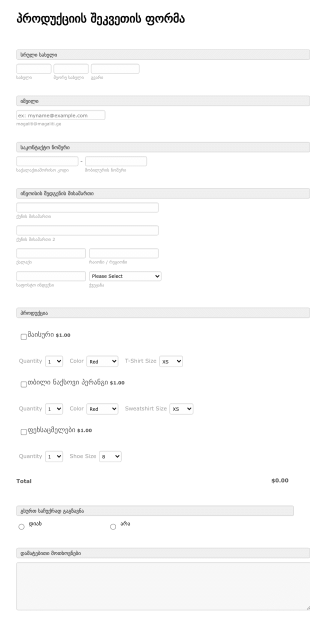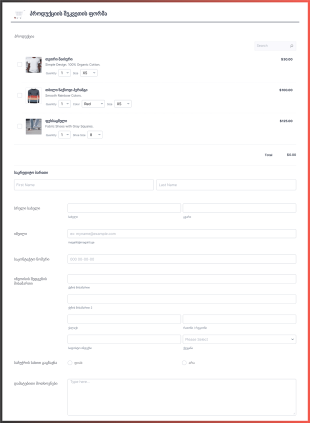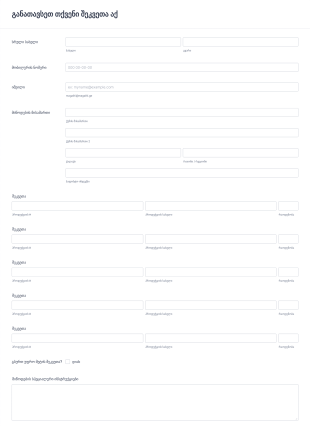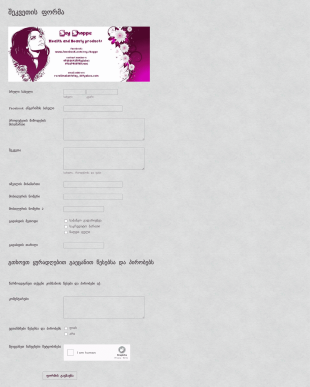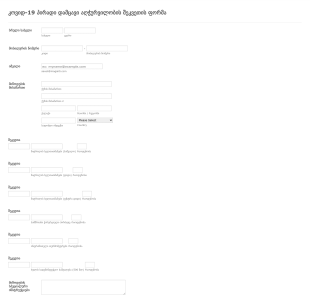შეკვეთის ფორმები
პროდუქციის შეკვეთის ფორმა
პროდუქციის შეკვეთის ფორმის შაბლონი არის სწრაფი საშუალება ონლაინ გაყიდვების დასაწყებად. შაბლონი არის სრულიად მორგებადი, საშუალებას გაძლევთ დაამატოთ ახალი ველები, შეუსაბამოთ თქვენი ბრენდის დიზაინს და დაამატოთ გასაყიდი პროდუქცია. რაც მთავარია, თქვენ შეგიძლიათ დააკავშიროთ მოცემული შეკვეთის ფორმა JotForm-ის პარტნიორ გადახდის სისტემას (30-ზე მეტი დაცული გადახდის ინტეგრაცია, მათ შორის Square, PayPal და Stripe) და მიიღოთ თანხა პირდაპირ თქვენი ფორმის გავლით, თავიდან აგარიდებთ დამატებით იმეილებს როდესაც შეკვეთის მიღების შემდეგ საჭიროა გადახდის დასრულება. ჩვენ არ ვიღებთ დამატებით საკომისიოს თქვენ მიერ გადახდების მიღებისას. პროდუქტიულობის უფრო მეტად გასაუმჯობესებლად, მარტივად აიჩიეთ JotForm-ის პროდუქციის შეკვეთის ფორმის შაბლონი და მოარგეთ დიზაინი თქვენი ბიზნესის მოთხოვნებს ჩვენი ფორმის მშენებლის გამოყენებით.
შეკვეთის გაუქმების ფორმა
შეკვეთის გაუქმების ფორმა საშუალებას აძლევს მომხმარებლებს გააუქმონ ან გადადონ თავიანთი ონლაინ შეკვეთა სანამ მოხდება შეძენილი ნივთების გაგზავნა. თუ თქვენ მართავთ ონლაინ მაღაზიას, გამოიყენეთ ჩვენი შეკვეთის გაუქმების სრულიად უფასო ფორმა რათა სწრაფად და მარტივად ადევნოთ თვალყური შეკვეთის გაუქმების მოთხოვნებს და თავიდან აირიდოთ შემდგომი პროცედურები. გამოიყენეთ ჩვენი ინტუიციური ფორმის მშენებელი რათა მოარგოთ ფორმა თქვენი ბიზნესის საჭიროებებს, შემდეგ კი გამოაქვეყნეთ თქვენს ვებსაიტზე. თქვენ მომენტალურად მიიღებთ და იხილავთ მონაცემებს თქვენს დაცულ Jotform ანგარიშში, მარტივად წვდომადი ნებისმიერი მოწყობილობიდან. თქვენ საკმაოდ ბევრი დრო დახარჯეთ რათა თქვენი ონლაინ მაღაზია ყოფილიყო გამორჩეული, ასე რომ დროა შექმნათ შეკვეთის გაუქმების გამორჩეული ფორმაც. ჩვენი ინტუიციური ფორმის მშენებლის გამოყენებით, თქვენ შეგიძლიათ მარტივად დაამატოთ ფორმის ველები, შეცვალოთ შაბლონის დიზაინი და პროფესიონალური ვიზუალისათვის დაურთოთ თქვენი კომპანიის ლოგო. გამოიყენეთ ჩვენი ინტეგრაციები, რათა ავტომატურად გაუგზავნოთ ფორმის მონაცემები თქვენს სხვა ონლაინ ანგარიშებს. გაუმარტივეთ მომხმარებლებს შეკვეთის გაუქმება ჩვენი ონლაინ ფორმის გამოყენებით - აღარ მოგიწევთ იდარდოთ დაგვიანებულ კომუნიკაციაზე.
პროდუქციის შეკვეთის ზოგადი ფორმა
პროდუქციის შეკვეთის ფორმა გამოიყენება ბიზნესიდან სასურველი პროდუქციის შესაკვეთად. ჩვენი პროდუქციის შეკვეთის სრულიად უფასო ფორმის გამოყენებით, ნებისმიერი ტიპის ბიზნესს შეუძლია სწრაფად გაყიდოს პროდუქცია და მიიღოს შეკვეთები ონლაინ! არ აქვს მნიშვნელობა თუ რა სახით გსურთ გადაიხადონ მომხმარებლებმა - ნაღდი ფულით თუ ონლაინ საბარათე გადახდებით - JotForm-თან ერთად ორივეს საკმაოდ მარტივად შეძლებთ. მოარგეთ ფორმა თქვენი ლოგოსა და პროდუქციის დამატებით, მოახდინეთ გადახდის სასურველ სისტემასთან ინტეგრირება და დაიწყეთ შეკვეთების მიღება. ფორმის ყველა მონაცემი უსაფრთხოდ შეინახება თქვენს Jotform ანგარიშში - მარტივად წვდომადი როგორც თქვენთვის ასევე თქვენი კოლეგებისათვის ნებისმიერი მოწყობილობიდან. ჩვენი შაბლონი არის ზოგადი სახის, ასე რომ ყველას შეუძლია მისი გამოყენება - ჩვენი ინტუიციური ფორმის მშენებლის გამოყენებით მარტივად შეგიძლიათ მოარგოთ დიზაინი თქვენი ბიზნესის მოთხოვნებს. უბრალოდ აიღეთ და ჩასვით სასურველი ელემენტები, დაამატეთ თქვენი პროდუქცია და ატვირთეთ შესაბამისი სურათები. პროდუქტიულობის უფრო მეტად დასაჩქარებლად, მოახდინეთ თქვენი ფორმის ინტეგრირება 130+ მძლავრ აპლიკაციასთან, მათ შორის Salesforce, Slack, monday.com, Google Drive, Box, Airtable და მრავალი სხვა. თუ თქვენი ბიზნესი შეკვეთების მისაღებად კვლავ იყენებს ქაღალდის ფორმებს, დროა შეაბიჯოთ მომავალში. დააჩქარეთ თქვენი სამუშაო პროცესები, შეამცირეთ ქაღალდის საქმისწარმოება და დაზოგეთ თქვენი კომპანიის ღირებული დრო და ძალისხმევა ჩვენი პროდუქციის შეკვეთის სრულიად უფასო ფორმოის გამოყენებით.
პროდუქციის შეკვეთის რეაქტიული ფორმა
ეძებთ შეკვეთის ფორმას რომელიც მოერგება ნებისმიერ მოწყობილობას? შეკვეთის ფორმის შაბლონი არის პოპულარული არჩევანი, განსაკუთრებით როდესაც საქმე ეხება ნებისმიერ მოწყობილობაზე მორგებად დიზაინს. მოცემული შეკვეთის ფორმა რომელიც შექმნილია JotForm-ის ბარათის ტიპის განლაგებით არის იდეალური გადაწყვეტილება როგორც დესკტოპ, ასევე მობილური მოწყობილობებისათვის. გადახდების დასამუშავებლად ის იყენებს Square-ს გადახდის სისტემას და აგროვებს თქვენი მომხმარებლების საკონტაქტო დეტალებს, გადახდისა და მიტანის მისამართს და პროდუქციის დეტალებს.
Other შეკვეთის ფორმები
შეკვეთის მარტივი ფორმა
ეს არის შეკვეთის მარტივი ფორმა რომელიც საშუალებას აძლევს მომხმარებლებს შეუკვეთონ მრავალი პროდუქცია თქვენი მაღაზიიდან. მოცემული ფორმის შაბლონის გამოყენებით, თქვენს მომხმარებლებს შეეძლებათ გამოგიგზავნონ შეკვეთები უბრალოდ სასურველი პროდუქციისა და რაოდენობის არჩევით. საჭიროების შემთხვევაში შესაძლებელია დამატებითი პროდუქციის არჩევა ან მიწოდების სპეციალური ინსტრუქციების დამატება. თქვენ შეგიძლიათ გამოიყენოთ მოცემული ფორმა როგორც ინვენტარიზაციის მართვის ხელსაწყო.
Go to Category:შეკვეთის ფორმებიშეკვეთის ფორმა გადახდის ინტეგრაციის
კოსმეტიკის შეკვეთის ფორმა გადახდის ინტეგრაციის გარეშე. გამოიყენება მომხმარებლებისგან სასურველი შეკვეთების მისაღებად.
Go to Category:შეკვეთის ფორმებიCOVID 19 პირადი დამცავი აღჭურვილობის ფორმა
კოვიდ 19 პირადი დამცავი აღჭურვილობის ფორმა
Go to Category:შეკვეთის ფორმები
